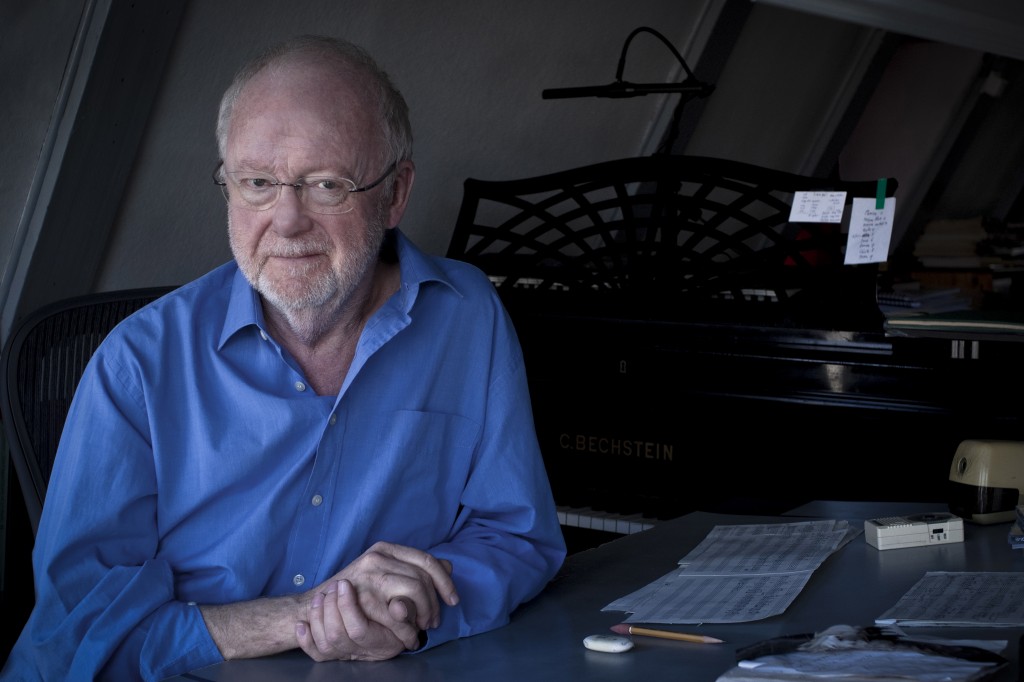The sheep are willing but the spirit is weak in Andriessen’s didactic “Materie”

Louis Andriessen’s “Materie” was performed Tuesday night at the Park Avenue Armory. Photo: Francesca Patella
Einstein demonstrated that matter and energy are one, merely different states of the same material. Louis Andriessen’s De Materie, which opened Tuesday night in a production at the Park Avenue Armory, attempts the parallel task, according to the synopsis, of demonstrating that “spirit relates to matter.” But where Einstein made his argument through a profound and elegant equation, Andriessen and director Heiner Goebbels favor the simplistic and the abstruse, and achieve far less.
De Materie is sometimes a vocal symphony with spoken narratives and sometimes an opera. Its four unrelated episodes jump from Dutch history to mystical Catholicism to Piet Mondrian and De Stijl to Madame Curie. To this neither-here-no-there form and method, Goebbels has added—in the North American premiere of this staging—a layer that mostly bores or baffles, though with passing moments of delight.
This is one heavy evening of music theater. The vastness of the hall allows for some unusual and striking elements: lighted blimps that loll through the air; swinging, colored lights dancing at the end of giant pendulums; a flock of sheep that wanders the hall, bleating, through most of the final part. The space is also tough on the music, shaving off the brightness from Andriessen’s orchestration, putting too much emphasis on the bottom edge.
Norbert Ommer’s sound design achieves an impressive blend of miked instruments and voices, yet the orchestral performance—ICE, conducted by Peter Rundel—didn’t serve the music or the space well. Opening with a leaden feel, and slow to develop energy, the playing brought out the worst features of Andriessen’s writing—repetitive, pulse-driven, stentorian. He is an unusually authoritarian composer, taking material—often a single chord—that is ordinary and repeating it with the blunt force of political propaganda until it asserts some level of importance.
This production of De Materie is predominately, and unfortunately, blunt-force. The idea that spirit and matter are related is ancient and pervasive, a feature of religious thinking and philosophizing the world over, examined by such disparate minds as Augustine and new-age marketers.
Both the music and the staging exacerbate the didactic lecturing style. In Part I, the choir sings portions of the 16th century declaration of a United Dutch Republic, followed by a 17th century description of the Dutch ship-building industry. Then tenor Pascal Charbonneau, heroically, sings texts from Dutch proto-scientist David van Goorle that argues that the whole is indistinguishable from its parts. The music pounds, the staging features the literal pounding of metal, it is all material and all overbearing.
Part II was beguiling, beautiful, and wholly successful. Soprano Evgeniya Sotnikova, as the poetess Hadewych, sang luminously, ICE’s accompaniment was graceful, and the staging was simple and effective. Set like a ghostly presence in the huge space, Sotnikova’s long phrases brought out the depth of spirit in the music and the words.
Andriessen has been lauded for incorporating jazz and popular music in his work, but his treatment is deadly. Part III, often performed as the standalone piece De Stijl, is based on a turgid version of a Motown baseline, with chugging saxophones aiming for some kind of funk. ICE has plenty of musicians who can play jazz without apology, but even they could only breath intermittent life into this dour music.
There was dancing in Part III, and it was in delightful contrast with the music: Gauthier Dedieu and Niklas Taffner performed Florian Bilbao’s swing choreography with wonderful, light-footed vivacity—a rare touch of spirit.
Everything collapses into nothingness in Part IV. The sheep arrive, mill about, then depart. The music is thin; fragments that eventually build to the chorus singing a line from Willem Kloos, “Dreams of beautiful death and eternal desire …” Then there is nothing but Madame Curie, at her table, first alone then surrounded by colleagues, lamenting the death of her husband.
Do the internal thoughts of the woman who discovered radiation relate spirit to matter? It seems so obvious and trite that it should not be so, but then De Materie is crippled by its scattershot nature: creating no context for itself, it exists entirely on the surface. Goebbels reinforces this with both the obvious—pounding metal and dancing—and the opaque—the blimps and the sheep.
The inescapable feeling is that neither composer or director trust the audience, and so they must either hector or mystify with the superior attitude that the audience are all rubes (or sheep).
De Materie runs every other day at the Park Avenue Armory, from March 24 through March 30 armoryonpark.org
Tea Sets DoMiTea Amber Jewelry Sleeping Bag




